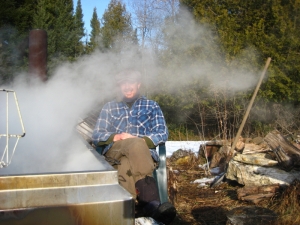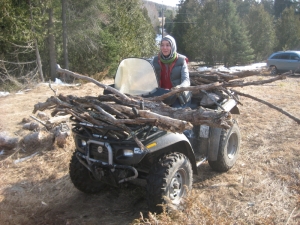This week, after months of shopping around, we finally bought a new maple syrup evaporator. It was supposed to be a quick and relatively easy decision this May about what to get. But, like most things in farming, once I started to drill down into it, I quickly realized it wasn’t so simple.
My doubts began when I visited the sugar bush of a local maple syrup equipment dealer. He showed me the nuts and bolts of his operation. He spoke of acid baths for the evaporator pans, malfunctioning valves, and finicky vacuum pumps. It was all a little bewildering, and made it sound like his main job was troubleshooting equipment problems. Later, another maple syrup producer told me how he has to wear ear protection when he’s working in his sugar shack, what with the din from the vacuum pump, the high pitched whine from the reverse osmosis, the blower in the stove, and myriad other small pumps all working to get his sap turned into syrup as quickly as possible. Meanwhile he’s multitasking to the extreme, monitoring gauges, adding firewood, adjusting valves, drawing off syrup…It sounded like working in the engine room of a battleship during combat.
Contrast this with my experience of making maple syrup over the past few years, just a few hundred taps at a time: long hours spent quietly working outside, feeling the first warm rays of the spring sunshine on my face, often just sitting and watching the fire burn as plumes of steam rise into the sky, listening to the first songbirds returned from the south. This is what I love about making maple syrup. Although being a ship’s engineer in battle no doubt carries a certain thrill with it, it’s not what I got into farming for. I got into farming to work in partnership with life – trees, plants, animals, microorganisms – to create a richer life for everyone.
As Aldo Leopold put it, “Bread and beauty grow best together. Their harmonious integration can make farming not only a business but an art; the land not only a food-factory but an instrument for self-expression, on which each can play music of his own choosing.”
I began to understand that the more we let technology intervene between us and the things we interact with, the less clearly we can see those things, and the more we see only the gauges and screens of our technology. If you farm from the seat of your tractor, you miss the crucial little details of what’s happening on the ground.
Deciding what kind of maple syrup equipment to buy forced me to clarify how I want to farm. Why, I asked myself, would I want to go the high tech route that most other maple syrup producers have taken, when the way that we produce our other crops is so divergent from the way most farmers do it? We have consciously chosen a lower tech approach with all these other crops, because we believe it will not only increase our enjoyment of farming, but also produce better quality food and improve our bottom line through reduced investment and maintenance costs. I like the idea of Appropriate Technology, which permaculture incorporates. One aspect of this concept is that you should understand and be able to fix all the technology you work with.
However, by taking the low road with technology, our yields will be less, and our work more. Can we run a financially sustainable business without adopting the latest production technology? Will turning what we know we love doing – small scale maple syrup making, gardening, wildcrafting – into a business destroy our enjoyment of these things?
Only time will tell, but I’m still willing to bet that we can do things in a way less mediated by technology, and still make a decent living. What is considered low tech now was high tech not that long ago. Agriculture has been following the high investment, high tech, high yield – and high debt and bankruptcy model for some time now. Maybe a lower tech, smaller output, but higher quality approach to production is what’s needed. Would you take a pay cut to move to a job that you enjoyed more? Most people would, I think, if they could still pay the bills at their new income level.
So in the end I chose to make maple syrup without a lot of the things that most producers now use: vacuum pumps, reverse osmosis machines, fans that blow on the fire. We bought a simple, well insulated evaporator, and the simplest filtering and bottling equipment available. It’s pretty much the way our grandparents made syrup, with one exception: we’re using tubing to collect the sap rather than buckets. Although I will miss going through the bush each day to empty buckets, and getting to know which trees are producing well, when you’re planning on doing 3000 taps, some concessions to efficiency need to be made. And tubing is a whole lot more efficient than buckets.
Who knows, maybe in the future I will eat all these words and embrace the modern world of maple syrup production. There is some technology that I consider more appropriate than others, such as a preheating system for the sap: it’s basically just pipes that the sap runs through, utilizing the steam from the boiling sap to preheat the sap before it enters the evaporator. This kind of technology meets my appropriate technology test, because it’s simple and makes use of energy that would otherwise be wasted, to increase the efficiency of the boil and lower the amount of wood I need to burn. The only reason we haven’t bought one from the get-go is the price – at about $4,500, we’ll wait a bit before making that investment.
I would also like to try out a relatively new product, which is smaller diameter tubes than are usually used. They are supposed to better create a natural vacuum in your lines when they run down steeper hills, meaning you can get the benefit of a vacuum pump without actually having to use one.
The point of Appropriate Technology is not to reject all modern technology. The point is to cast a critical eye on the technology you use, and consider it with a wider view than just, “Will this new thing pay for itself with increased production/efficiency/revenue?” Appropriate Technology challenges us to think holistically about technology and ask questions like, “How will this new thing affect my enjoyment of my work?”, “Will it have a negative or positive effect on natural ecosystems?” or, “Will it make me dependent on the outside experts who sell and service this technology?” Then you weigh the pros and cons and decide for yourself. The laptop I am currently writing on is not very appropriate, yet I think it’s too powerful a tool to reject.
Most people think the Amish have rejected all modern technology, but it’s not quite that simple. Their barns and workshops are full of modern, electric power tools. But the power lines don’t go to their houses. They’ve looked at the wider social implications of modern technology, and decided to take a pass – except for those things that are really useful and pretty benign.
I’m not saying I want to live like the Amish. But I do think we’d do better as individuals and as a society if we thought more carefully about how technology affects us, rather than blindly accept everything that’s faster, bigger, and more powerful. We have become aware in the past few decades that new, more powerful technology can sometimes have a detrimental effect on the environment, but we still lag behind in our thinking about how new technology can negatively affect the quality of our work environment.

